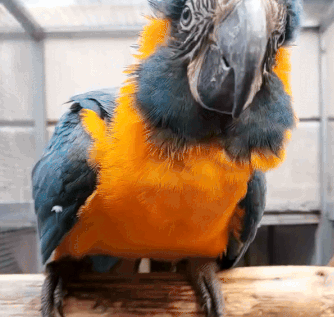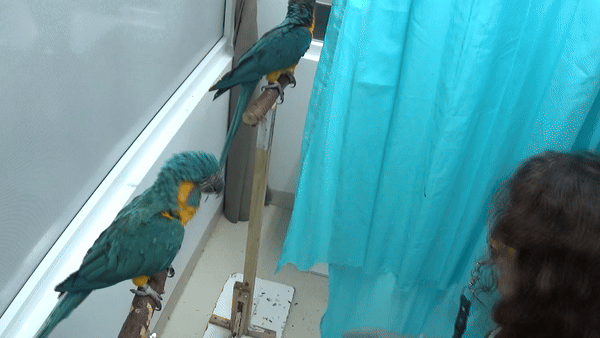Material & Methods
I tested six blue-throated macaws (Ara glaucogularis) at the Comparative Cognition Research Group in Loro Parque Fundación, Tenerife.
In order to take part in my experiment, each macaw had to be trained for the following:
BASE BEHAVIORS
All individuals were trained to perform five different motor actions (here called base behaviors), three of which were randomly selected and attributed to each subject.
These behaviors were used as the motor actions required in the next two training plans (copy and repeat training) and included lifting a leg, opening the wings, raising the head or body feathers, vocalizing and spinning.

COPY TRAINING
Consisted in the macaw copying a motor action demonstrated by a conspecific.
Two hand commands given in succession: “to pay attention to the conspecific” and “to copy the conspecific”.
“Pay attention” was only given to the macaws in this context. Likewise, “copy” was always given after the “pay attention” command.
A session of copy training consisted of 24 trials.

REPEAT TRAINING
Consisted in the macaw repeating the last motor action it performed.
The macaws were first asked to perform a base behavior through its corresponding hand command, such as spinning.
Upon completion, the macaw was then asked through a general hand command to repeat the last behavior it performed.
A session of repeat training consisted of 24 trials.

Testing phase
After being habituated to routinely participate in copy training sessions, on testing day, macaws were brought to what seemed to be just another copy training session. The first 11 trials went as usual, with the subject being asked in every of them to copy the action of a conspecific after being asked to pay attention to it.
Suddenly, on trial 12, following the pay attention command, the macaw was asked to repeat the behavior they performed in the previous trial (trial 11), instead of copying the conspecific in the current trial (trial 12) as usual. Following it, all remaining trials carried on as a regular copy session, as if nothing happened.
Macaws were tested three times each. Time spent looking at the hand command for copy (expected command) and repeat (unexpected command) were also recorded, in order to assess the violation of expectation effect.